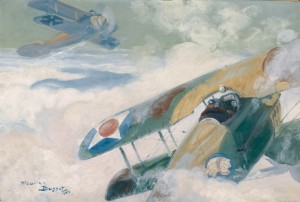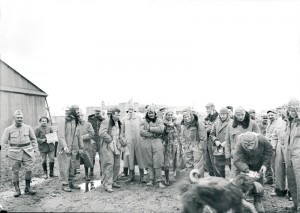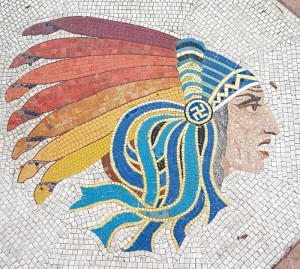
Aerial combat. 1918. Painting by Maurice Busset. © Paris, musée de l’Armée dist. RMN-GP image musée de l’Armée
American Volunteers
The American Pilots
Enlisted in the Foreign Legion or in British military forces, many American volunteers chose to undergo training to either join the French Air Service or the Royal Naval Air Service.
La Lafayette Escadrille
William Thaw II, Norman Prince and Elliott Christopher Cowdin II, three Americans volunteers serving in France worked tirelessly with French authorities in order to form an all-American squadron. In December 1915, while on leave they returned to the United States where their proposition was received favourably by the American public opinion as they were given considerable publicity. After lengthy negotiations and support from French and American public figures, they obtained full satisfaction. In March 1916, French Air Service – France’s “Service Aeronautique” organized an American squadron. The “Escadrille Américaine N (Neuport) 124” was officially created on 16 April 1916. The original squadron had seven pilots: Norman Prince, William Thaw II, Elliott Christopher Cowdin II, Victor Chapman, James R. McConnell, Kiffin Yates Rockwell and Bert Hall under French command. However, in order to avoid that the Germans started a propaganda war since they were bound to look at the creation of the American squadron as proof of America’s breech of neutrality in the conflict, the squadron was designated “Escadrille des Volontaires” on 13 November 1916, and finally “Escadrille 124 La Fayette” on December 1916. As the number of American volunteers soon exceeded the capacity of the squadron, the American pilots flew in the so-called Lafayette Flying Corps (also known as the Franco-American Flying Corps) not a unit per se but an appellation regrouping all American pilots who served in the French Air Service until 1917, including those serving in the Lafayette Escadrille.
23 months of active duty
In April 1916, the American pilots were moved to their new base at Luxeuil-les-Bains in the Haute-Saône region where they met their two French squadron leaders Captain Georges Thenault (1887-1948) and Lieutenant de Laage de Meux (1891-1917). Engine mechanics, drivers, gunsmiths, motorcyclists, telephone operators, wireless operators, stretcher bearers and secretaries were also assigned to the squadron. During its 23 months of active service, there were 45 pilots in the roster: 38 American pilots and 5 French officers who were involved in combat engagements all over the Western front. Although the military impact of its actions was rather modest, its pilots played a major role in mobilizing American public opinion.
Under American Command
In December 1917, the N124 Lafayette Escadrille fully equipped with Spads was designated SPA124 Lafayette Escadrille and placed under the command of Thaw.
In February 1918, all the American pilots were dismissed from the French Army and transferred to service in the U.S. American Expeditionary Forces (A.E.F.) in Europe. The disbanded Lafayette Escadrille and Lafayette Flying Corps were transferred to the 103rd Aero Squadron, an aviation pursuit squadron of the U.S. Air Service.




Ajouter un commentaire